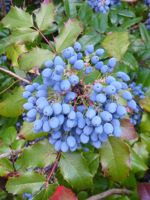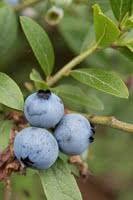Mon-Fri 9am - 5pm Mountain time
Oregon Grape vs Lowbush Blueberry
Mahonia aquifolium (Berberis aquifolium)
Vaccinium angustifolium
NOT AVAILABLE THIS SEASON - MIGHT RETURN
Oregon Grape is an evergreen shrub native to North America, found along the Pacific coast. In spring, the bright golden-yellow flowers appear in clusters above the leaves. These flowers eventually give way to edible blue berries in late summer. While not a true grape, the berries appear grape-like due to their colouring and clustered growth. They can be eaten fresh, but the sour taste and high amounts of natural pectin make them well suited for preserves.
The Oregon Grape has leaves that are glossy, leathery, and spiny-edged. This feature gives it its alternate name of Holly-leaved Barberry. When the leaves emerge in the spring they are a bronze-red colour. In the summer they transition to green, followed by bright red to deep burgundy in the fall. Leaves are retained throughout the winter and colder temperatures cause the leaves to turn purplish bronze, providing year round interest to the landscape.
Lowbush Blueberry, commonly known as the Wild Lowbush Blueberry, is often wild-harvested and thrives in low pH acidic soil. This early low-bush blueberry produces white and pink bell-shaped flowers in the spring. Its fruit is smaller in size than high bush blueberry plants and is more flavourful with an intense blueberry taste-masking it perfect for fresh eating, baking, and preserves.
Note: Blueberries require very specific soil conditions. They need well-drained soil with a pH between 4.5 and 5.0. If the starting pH of your soil is between 5.1 and 6.2 you can lower it by adding sulfur. We recommend against planting blueberries in soil with a starting pH greater than 6.2. Please do your own research before buying any blueberry plants.

